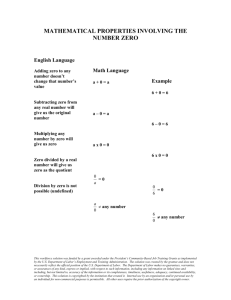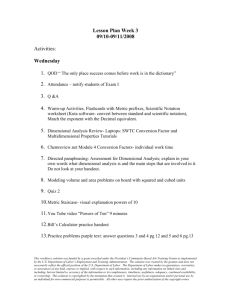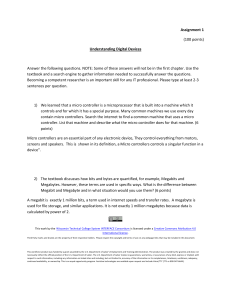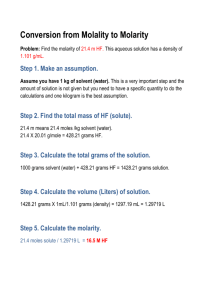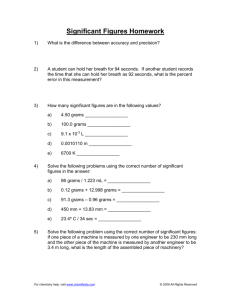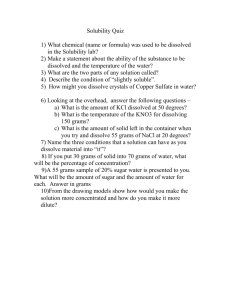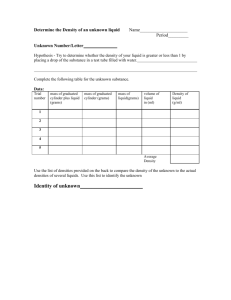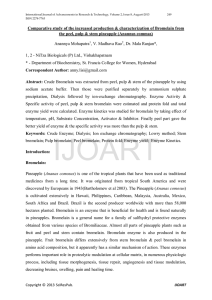Density Problems Worksheet: Practice & Solutions
advertisement
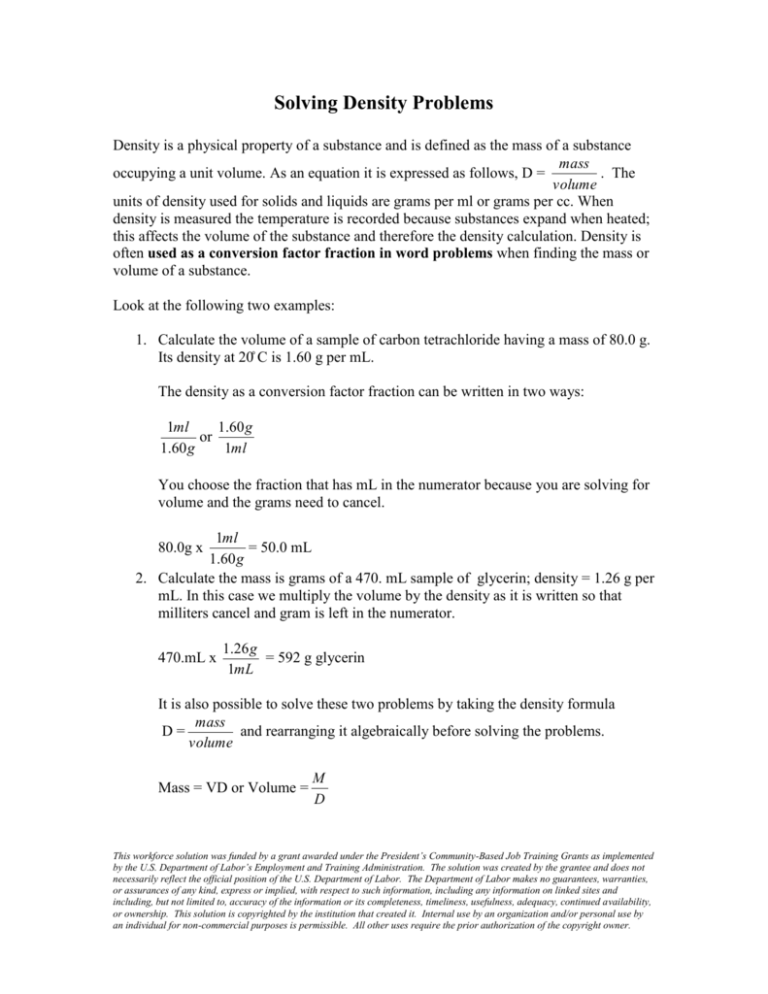
Solving Density Problems Density is a physical property of a substance and is defined as the mass of a substance mass occupying a unit volume. As an equation it is expressed as follows, D = . The volume units of density used for solids and liquids are grams per ml or grams per cc. When density is measured the temperature is recorded because substances expand when heated; this affects the volume of the substance and therefore the density calculation. Density is often used as a conversion factor fraction in word problems when finding the mass or volume of a substance. Look at the following two examples: 1. Calculate the volume of a sample of carbon tetrachloride having a mass of 80.0 g. Its density at 20̊ C is 1.60 g per mL. The density as a conversion factor fraction can be written in two ways: 1.60 g 1ml or 1ml 1.60 g You choose the fraction that has mL in the numerator because you are solving for volume and the grams need to cancel. 1ml = 50.0 mL 1.60 g 2. Calculate the mass is grams of a 470. mL sample of glycerin; density = 1.26 g per mL. In this case we multiply the volume by the density as it is written so that milliters cancel and gram is left in the numerator. 80.0g x 470.mL x 1.26 g = 592 g glycerin 1mL It is also possible to solve these two problems by taking the density formula mass D= and rearranging it algebraically before solving the problems. volume Mass = VD or Volume = M D This workforce solution was funded by a grant awarded under the President’s Community-Based Job Training Grants as implemented by the U.S. Department of Labor’s Employment and Training Administration. The solution was created by the grantee and does not necessarily reflect the official position of the U.S. Department of Labor. The Department of Labor makes no guarantees, warranties, or assurances of any kind, express or implied, with respect to such information, including any information on linked sites and including, but not limited to, accuracy of the information or its completeness, timeliness, usefulness, adequacy, continued availability, or ownership. This solution is copyrighted by the institution that created it. Internal use by an organization and/or personal use by an individual for non-commercial purposes is permissible. All other uses require the prior authorization of the copyright owner. In this case the numbers given are substituted into the equation and the same answer results. Both methods are mathematically equivalent. It is essential that you include units throughout your calculation as a check. Practice solving the following density problems. Be sure to include the correct number of significant figures in your calculations. Part 1. Calculate density in g per mL for each of the following: a) a piece of metal of volume 55 ml and a mass of 230 g. b) a reagent occupying a volume of 48.0 mL and having a mass of 140. g. c) a sample of an alloy occupying a volume of 6.8 mL and having a mass of 0.720 g. Part 2. Calculate the volume in mL occupied by each of the following: a) a sample of glycerin having a mass of 1.80 x 103 g; Density = 1.26 g per mL b) a sample of chloroform having a mass of 39.7 g; Density = 1.49 g per mL c) a sample of sulfuric acid acid having a mass of 284 g; Density = 1.84 g per mL This workforce solution was funded by a grant awarded under the President’s Community-Based Job Training Grants as implemented by the U.S. Department of Labor’s Employment and Training Administration. The solution was created by the grantee and does not necessarily reflect the official position of the U.S. Department of Labor. The Department of Labor makes no guarantees, warranties, or assurances of any kind, express or implied, with respect to such information, including any information on linked sites and including, but not limited to, accuracy of the information or its completeness, timeliness, usefulness, adequacy, continued availability, or ownership. This solution is copyrighted by the institution that created it. Internal use by an organization and/or personal use by an individual for non-commercial purposes is permissible. All other uses require the prior authorization of the copyright owner. Part 3. Calculate the mass in grams of each of the following: a) a 40.0 mL volume of ether; Density = 0.708 g per mL b) a 8.25 mL volume of ethyl alcohol; Density = 0.789 g per mL c) a 4.00 x 10–2 L volume of vegetable oil; Density = 0.91 g per mL ANSWER KEY: Solving Density Problems Part 1 a) 4.2 g per mL b) 2.92 g per mL c) 0.11 g per mL Part 2 a) 1430 mL b) 26.6 mL c) 154 mL Part 3 a) 28.3 g b) 6.51 g c) 36 g This workforce solution was funded by a grant awarded under the President’s Community-Based Job Training Grants as implemented by the U.S. Department of Labor’s Employment and Training Administration. The solution was created by the grantee and does not necessarily reflect the official position of the U.S. Department of Labor. The Department of Labor makes no guarantees, warranties, or assurances of any kind, express or implied, with respect to such information, including any information on linked sites and including, but not limited to, accuracy of the information or its completeness, timeliness, usefulness, adequacy, continued availability, or ownership. This solution is copyrighted by the institution that created it. Internal use by an organization and/or personal use by an individual for non-commercial purposes is permissible. All other uses require the prior authorization of the copyright owner.
